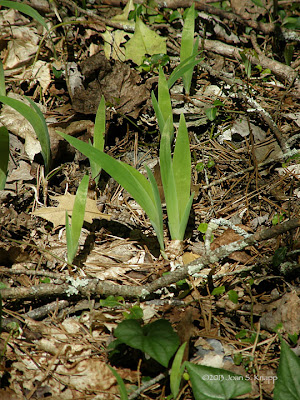The road into Dicks Creek passes through a lot of privately owned land before it reaches the wildlife
management area. The road side had been mowed and the area didn’t look very
promising. Our first reward for persisting was…
coming around a bend in the road and getting a beautiful view of a waterfall on Dicks Creek.
We continued up the road
and it was a while before we found our first prizes of the afternoon. In the
open, on a west-facing slope, we found a patch of
Podophyllum peltatum (Mayapple, May Apple, May-apple, American Mandrake) plants,
Most plants were single-stemmed and not setting blooms. Only a few had ‘split’ stems with developing buds. Mayapples may be found in many counties in the Piedmont counties in Georgia.
And, hiding in plan sight on the embankment below them was a row
of…
An individual flower. These plants always look too delicate to be thriving and flowering in full sunlight.
The road continued along the hillside in a relatively open area
above the creek and we spotted plants I would have expected to find in more
sheltered areas.
A couple of Polygonatum biflorum (Solomon’s Seal) plants that were…
Beginning to set blooms. These plants are also found in the Piedmont counties of Georgia.
From the open area, the road passed by a series of steep,
sheltered embankments that were moist compared with the open areas. Here we
found promise of a variety of wildflowers.
Iris – probably Iris cristata (Dwarf Crested Iris) - were sprouting. This species is found mostly in north Georgia counties.
We found a single plant in bloom, a harbinger of things to come.
A close view of the flowers.
Another surprise. We found a couple of Sanguinaria canadensis (Bloodroot, Red Puccoon) plants.
This species may be found in some coastal plain counties as well
as in Piedmont counties.
In this section of the road, we had seen some favorites and also
some new wildflower plants – Trailing Arbutus, Dwarf Crested iris, and
Bloodroot.
The road forded Dicks Creek and climbed up the side of the hills
to parallel the creek at a slightly higher elevation. There were some treasures still to come...
Click
on an image to view a larger image
Identification Resources:
Southeastern Flora
Natural
and Naturalized Plants of the Carolinas and Georgia:
Distribution:
United
States Department of Agriculture Plants Database:
Related
post:












































